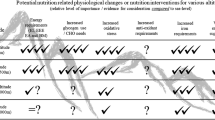Abstract.
An important component of survival time during cold exposure is shivering endurance. Nine male and three female healthy and fit subjects [mean (SD) age 24.8 (6.3) years, body mass 71.7 (13.2) kg, height 1.75 (0.10) m, body fat 22.7 (7.4)%] were immersed to the upper chest level in cold water for periods ranging from 105 to 388 min on two occasions to test a prediction of shivering endurance. The water was cooled from 20 to 8°C during the first 15 min of immersion and subsequently rewarmed (<20°C) to elicit a near constant submaximal shivering response. The data were divided according to moderate (M) and high (H) levels of shivering intensity. Respective mean total immersion times were 250 (75) and 199 (80) min (P=0.086) at different average shivering intensities of 61 (10) and 69 (8)% relative to maximal shivering (P<0.001). Blood plasma glucose concentration increased during the immersion [from 3.44 (0.54) pre- to 3.94 (0.60) mmol·l–1 post-immersion (P=0.037)] and levels were higher during M (P=0.012). When compared to a model prediction of shivering endurance, shivering activity continued well beyond the predicted endurance times in 18 out of the 24 trials. The average rates of oxygen consumption over the entire immersion period were lower (P=0.002) during M [0.93 (0.20) l·min–1] compared to H [1.05 (0.21) l·min–1), and while these rates did not change during the last 90 min of immersion, there was an increase in fat oxidation. There were no trial differences in the average esophageal (T es) and mean skin temperatures during the entire immersion period (36.0 and 18.0°C, respectively), yet T es decreased (P=0.003) approximately 0.4°C during the last 90 min of immersion. When the shivering intensity was normalized to account for this decrease, a significant downward trend of approximately 17%·h–1 in the normalized shivering intensity was found after the predicted end of shivering endurance. These results suggest that shivering drive, and not shivering intensity per se, decreased during the latter stages of the immersion. Underlying mechanisms such as fatigue and habituation for this diminishing cold sensitivity are discussed.
Similar content being viewed by others
Author information
Authors and Affiliations
Additional information
Electronic Publication
Rights and permissions
About this article
Cite this article
Tikuisis, .P., Eyolfson, .D., Xu, .X. et al. Shivering endurance and fatigue during cold water immersion in humans. Eur J Appl Physiol 87, 50–58 (2002). https://doi.org/10.1007/s00421-002-0589-1
Accepted:
Issue Date:
DOI: https://doi.org/10.1007/s00421-002-0589-1




